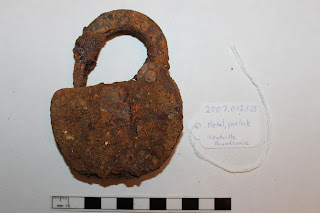Historical Object Photography
My conservation work on the Kentville Railway Roundhouse objects is nearing completion of the cleaning phase with only a few objects left to work on. I have started taking photographs to upload to the Kings County Museum collections database called www.novamuse.ca. The museum is now closed for the winter (opening again in mid-March 2013) so this gives me an opportunity to add all the roundhouse objects information onto the database and include higher resolution photographs which I took on Thursday December 20. Conservators refer to historical object photography as record photography. Our goal is to produce photographs that allow viewers to see the objects as much as possible in their natural state that shows their true colours, shape, identifying marks, and condition and for researchers to zoom in for as much details as possible for such things as maker's marks. Since we do not have a true photographic studio we have used what equipment we have on hand as donated to the museum or what photographers are willing to lend us. The photograph below is the set up I used for this purpose. The essential and basic pieces of equipment as shown are: a DSLR camera, a tripod, a light box, spotlights, and a scale (not shown here). The light box in this case provides a white background on all sides as well as top and bottom. The light box is a portable one that is easily assembled from a folded up state.
 |
| Record photography light box set up |
I found that 4 spotlights worked best: two at the top and one on each of the left and right sides. All are angled towards the middle where the object will be placed. The spotlights are not ideal but work reasonably well for our purposes. It would be best to use a type of light that is diffused. That is, not so focused, but we had none available at this time. The spot lights are set up to not touch the sides of the light box because they get quite hot. You can see in this photograph how the object is placed in the middle with white sides all around and soft light throughout. It is best to remove all other sources of light such as overhead lights and from windows which can reflect off the objects.
Here are some of the guidelines I use when taking record photographs of historical objects:
- use a DSLR (Digital Single Lens Reflex) camera where possible although some point and shoot cameras do work well. I have used a Canon PowerShot with good results,
- most objects can be photographed at about a 45 degree angle,
- use the largest sized JPEG setting or RAW setting but remember that RAW takes up considerable space,
- use custom white balance (photograph the white space anywhere in the light box and use it to set the white balance),
- position the lights to highlight the object with as little reflection as possible,
- use macro setting for close up of identifying marks if there are any,
- use a scale nearby but not touching the object,
- angle the object if it highlights any markings otherwise they should be straight vertically or horizontally,
- take at least four photographs: one from the top the other from the bottom both with and without the label.
Below is an example of the photographs I took of a power line insulator. Each one has the label shown beside it where the accession number can be used to do a search on www.novamuse.ca to get additional information. I usually take the same pictures without the label to put on the database. Having the label here simply makes it easier for anyone to do follow up on research if they are starting from this BLOG. In this case the accession number on the label is 2007.012.021
 |
| Power line insulator - top |
Do-it-yourself Tip: In the past I have made a small light box when a commercial one is not available. You can use a large box placed on one of its long sides. Cut openings on the two narrow sides and top (the other long side) and cover the openings with white tissue paper. I have then used ordinary lamps (desk lights) shining through the tissue paper as lighting. Place a sheet of white paper large enough to cover the back and curve onto the bottom. Place the object in the middle of this to take your photographs.






































